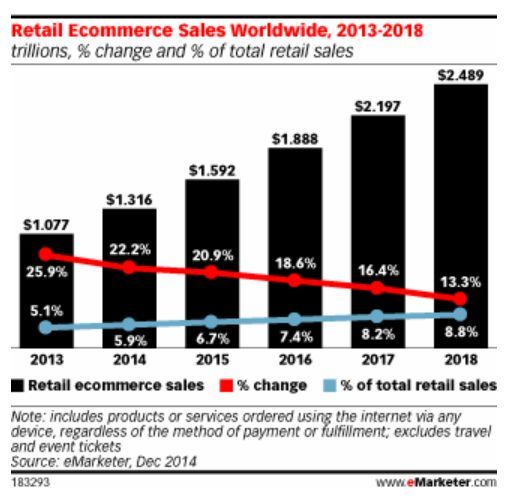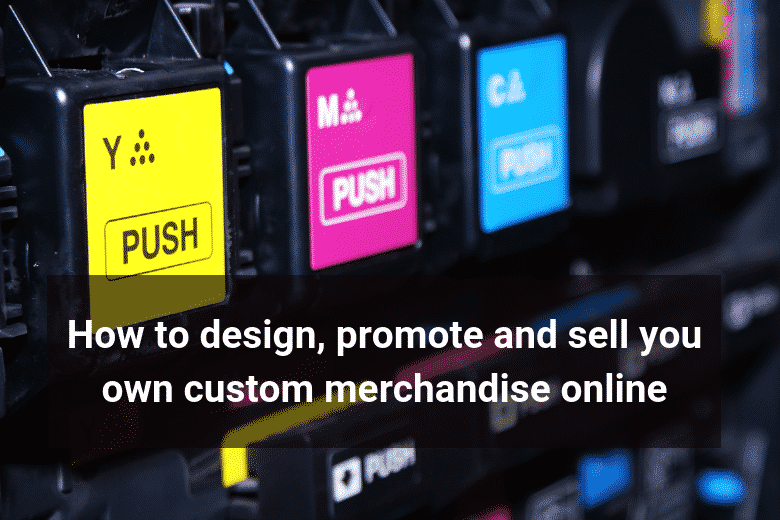How to design, promote and sell your own custom merchandise online
With screens of various sizes and descriptions becoming the conduits for contemporary window shopping, it’s no wonder worldwide eCommerce is set to be worth almost $2.5 trillion in 2018. From big players to small family stores, the digital marketplace invites everyone to join the party. This is largely owing to technological developments that make setting up a profitable shop simple for anyone, regardless of technical know-how.

Source: Retail Ecommerce Sales Worldwide, 2013-2018
The process of creating and selling your own custom merchandise has two software tiers. The first consists of an eCommerce platform, and the second is its integration with a print-on-demand (POD) service, partner, or platform. Later, I will take you through how these components can work together to generate profit with minimal startup costs.
But first, let’s have a look at what POD is, and how it has paved a new pathway for creatives and business owners of all descriptions.
What is print-on-demand?
As it gains traction in the digital marketplace, the term “print-on-demand” is becoming more of a household name. If you are not yet familiar, POD refers to a new manufacturing method where printing takes place only once a customer has ordered a product. That’s right, it’s on demand. This allows the retailer to provide goods to a customer that are customised, convenient, and come at very low risk to all involved.
POD was born in the publishing industry as a response to the crisis of relevance that accompanied the dawn of digital. With more and more people consuming content on screens, the mass production of books no longer makes good business sense.
Through the convergence of new technologies, POD means that books no longer have to be printed in bulk and can be produced only when needed. Now, other forms of merchandise are following suit, realising the massive potential this process can have in aligning with the demands of the online marketplace.
With POD, you do not have to play guessing games when it comes to stock ordering. You no longer have to populate shelves in the hope that the goods will turn to cash. In fact, you eliminate your involvement in the manufacturing process almost entirely:
- Your customer orders from your online store
- The order is sent directly to an outsourced printer (via the software)
- The order is shipped to your customer
Notice how free the merchant is from the complex manufacturing, printing, and delivery process? This is the benefit of POD eCommerce.
How to get started
If you’ve decided that POD is going to revolutionise your business or form the grounds for a new one, your next step is going from idea to implementation – often the most challenging step for entrepreneurial endeavours.
Luckily, when it comes to setting up a custom merchandise outlet, the process is simple enough for anyone, regardless of expertise (and procrastination.)
Choose your platforms and integrations
- Your eCommerce platform:
If your goal is a self-contained basic outlet for custom merchandise, you do not need to hire a web developer or have advanced experience with technology. Platforms like Shopify, WooCommerce, and Magento, to name just a few, are user-friendly and self-contained. Setting up shop is not more challenging than creating a Facebook account these days.
If you already have a business website with traffic directed towards it, it might make more sense to go with an eCommerce plugin. Shopify also offers this option, as does WooCommerce and most others. As this is a slightly more complicated process, you might want to engage a developer – but this is by no means essential.
- Your POD partner or platform:
Now for the crucial phase that will become the heart of how your business runs – integrating a print-on-demand solution for your merchandise. This is part and parcel of deciding on what eCommerce platform to use, as you have to make sure that the option you choose is compatible with your POD platform.
Making the right choice here is crucial for your peace of mind down the line. The platform should be invisibly hosted on a subdomain, working seamlessly with your store and leaving you to concentrate on fun product ideation, catalogue development, and marketing.
Designing your merchandise
The first question to ask yourself when designing your merchandise is who you are going to be designing it for? What is the purpose of this endeavour in terms of the brand’s future?
- Merchandise for brand awareness:
If you are designing merchandise to improve the brand identity of a business that is already in existence, POD merchandise offers you the opportunity to do so with physical products. This does not have to be for a corporate venture. POD might just be the tool you’re looking for to create merch when you get the band back together!
- When the merchandise is your product:
This option will work for you if you’re looking to start your business from scratch. Put designs on a t-shirt, a smartphone cover, a tote bag… the list goes on and on. Don’t worry if you failed art class in high school; you don’t necessarily have to do the designs yourself. Hire a freelancer from one of the many platforms. Always provide detailed and clear briefs to prevent disappointment and added cost.
- Printing your own artwork:
For artists, POD provides a whole new avenue to sell your work. Your store can serve as an online gallery where your work can be printed and shipped without you doing any of the slog work. You’d be in good company. Many of the leading art galleries and museums are utilising this method to print and sell versions of the work in their collections around the world.
Now that you’ve got your products ready, it’s time to get them sold…
Promoting and selling
Before you start selling, do research on whether you need a business licence for your particular endeavour. This will be based on your country and location, and can be acquired at a local, state or national level – depending on what you’re selling. Getting the right paperwork should be tackled at the beginning of your venture, not when negligence threatens your business down the line.
Once you get the bureaucratic go-ahead, the next adventure is your brand identity. It’s no longer always necessary to employ expensive agencies to hone aesthetics for you. Smart online tools such as Shopify’s Hatchful allow you to create beautiful logos effortlessly. Now, it’s time to get noticed and start to sell with POD eCommerce.
Social-focused digital marketing
For the first time in retail history, you’re privy to eerie levels of detail about your customers. This is a marketer’s dream, providing insights about preferences and habits that generations of entrepreneurs before have only dreamt about. The question is how to harness this information in a way that benefits both you and your customers. Your first port of call is to gain an understanding of the digital marketing landscape; with social at the forefront.
Capitalise on paid and organic social by making use of a multi-platform strategy. Facebook and LinkedIn groups will help you generate buzz organically. Facebook’s unrivalled ad platform will help you reach new audiences with a small budget. Instagram is on a steady rise, currently boasting over 800 million active users. Instagram is still the congregation point for influencers. Capitalising on this marketing strategy can be what turns your products viral.
Pinterest is another super platform for visual marketing, and a hotbed for creative research and inspiration. The option for organic growth via Pinterest is fantastic, and the channel’s ad platform is getting better every year. The “buyable pins” function also allows merchants to sell directly via Pinterest, which is a useful addition to your established eCommerce platform.

Source: Shopify
Omnichannel sales
“Omnichannel” is the new buzzword in eCommerce marketing. Yes, it means that you can sell your goods on various sales platforms online – but it doesn’t end there. It also means you do not have to confine your marketing efforts to one digital or non-digital channel. As a merchant, you must find all possible routes to maximising the sales of your products.
Particularly if you have a brick and mortar shop, or would like to include one in your business model for the future, having an eCommerce store does not mean you have to go fully digital in everything you do. eCommerce payment solutions have taken this into account, allowing you to take integrated credit card purchases from wherever you sell your goods.
Shipping your custom merchandise
Once your business is up and running and orders start coming in, you will need a way to ship your custom merchandise to your customers around the globe. Floship can help you with that. As a Tech-Powered eCommerce Fulfillment provider, we provide businesses with end-to-end logistics solutions. From receiving orders through our fully integrated Floship Portal, through processing, pick & pack and delivering the goods – all against competitive rates and handled with dedication and transparency. Get your quote now and start shipping today.
Summary
If you’re looking for the quick answer to the question of whether you should start selling custom merchandise online, here it is: try it. It’s low risk and easy. Thanks to industry disruptions such as POD, you can be selling unique merchandise through an online store in a matter of hours – without having major upfront costs or risk to contend with.
Whether you are looking to experiment with a new business, boost an established enterprise, or if you are a creative person looking to monetise artwork – the integration of POD with eCommerce may be your launchpad for success with an online store.
AUTHOR BIO
Charlie Carpenter is the co-founder and CEO of Kite. He is a mobile advocate with over ten years of industry experience.
After working for large and small agencies for many years, he co-founded Kite; a software solution for print-on-demand, zero inventory merchandise, and personalised photo print goods. As well as an entrepreneur, Charlie is a seasoned product strategist with experience of various types of digital projects which include: Responsive and Adaptive Websites, Mobile & Tablet Apps, Hybrid Apps, Cross Platform App development.
You can connect with Charlie on LinkedIn, and follow him on Twitter.

Ready To Upgrade Your Logistic Solution?
Speak to Floship ecommerce logistic consultant about improving your global support chain today




